engine FIAT FULLBACK 2017 Owner handbook (in English)
[x] Cancel search | Manufacturer: FIAT, Model Year: 2017, Model line: FULLBACK, Model: FIAT FULLBACK 2017Pages: 312, PDF Size: 12.31 MB
Page 259 of 312

Fluid type
Brake fluid conforming to DOT 3 or
DOT 4 should be used. The reservoir
cap must be fully tightened to avoid
contamination from foreign matter or
moisture. DO NOT ALLOW
PETROLEUM- BASED FLUID TO
CONTACT, MIX WITH, OR OTHERWISE
CONTAMINATE THE BRAKE FLUID.
SEAL DAMAGE WILL RESULT.
373)
WARNING
373)Clutch fluid is poisonous and highly
corrosive. In the event of accidental
contact, immediately wash the affected
parts with water and mild soap. Then rinse
thoroughly. Call a doctor immediately if
swallowed.
POWER STEERING
FLUID
374)
3)
To check the fluid level
Check the fluid level in the reservoir
while the engine is idling. Check to
make certain that the power steering
fluid level is always between the “MAX”
and “MIN” level markings on the fluid
reservoir and top up the fluid, if
necessary.
WARNING
374)Prevent power steering fluid from
coming into contact with hot engine parts:
it is flammable.
IMPORTANT
3)Power steering fluid consumption is
extremely low; if another top-up is required
after only a short period of time, have the
system checked for leaks at a Fiat
Dealership.
460AHA102582
257
Page 260 of 312
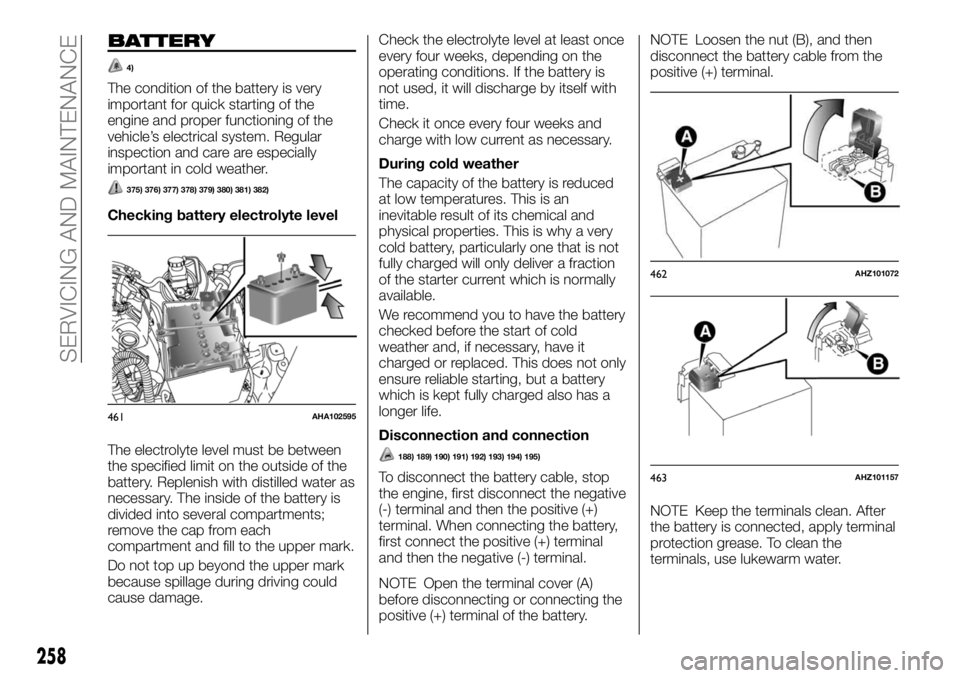
BATTERY
4)
The condition of the battery is very
important for quick starting of the
engine and proper functioning of the
vehicle’s electrical system. Regular
inspection and care are especially
important in cold weather.
375) 376) 377) 378) 379) 380) 381) 382)
Checking battery electrolyte level
The electrolyte level must be between
the specified limit on the outside of the
battery. Replenish with distilled water as
necessary. The inside of the battery is
divided into several compartments;
remove the cap from each
compartment and fill to the upper mark.
Do not top up beyond the upper mark
because spillage during driving could
cause damage.Check the electrolyte level at least once
every four weeks, depending on the
operating conditions. If the battery is
not used, it will discharge by itself with
time.
Check it once every four weeks and
charge with low current as necessary.
During cold weather
The capacity of the battery is reduced
at low temperatures. This is an
inevitable result of its chemical and
physical properties. This is why a very
cold battery, particularly one that is not
fully charged will only deliver a fraction
of the starter current which is normally
available.
We recommend you to have the battery
checked before the start of cold
weather and, if necessary, have it
charged or replaced. This does not only
ensure reliable starting, but a battery
which is kept fully charged also has a
longer life.
Disconnection and connection
188) 189) 190) 191) 192) 193) 194) 195)
To disconnect the battery cable, stop
the engine, first disconnect the negative
(-) terminal and then the positive (+)
terminal. When connecting the battery,
first connect the positive (+) terminal
and then the negative (-) terminal.
NOTE Open the terminal cover (A)
before disconnecting or connecting the
positive (+) terminal of the battery.NOTE Loosen the nut (B), and then
disconnect the battery cable from the
positive (+) terminal.
NOTE Keep the terminals clean. After
the battery is connected, apply terminal
protection grease. To clean the
terminals, use lukewarm water.
461AHA102595
462AHZ101072
463AHZ101157
258
SERVICING AND MAINTENANCE
Page 263 of 312
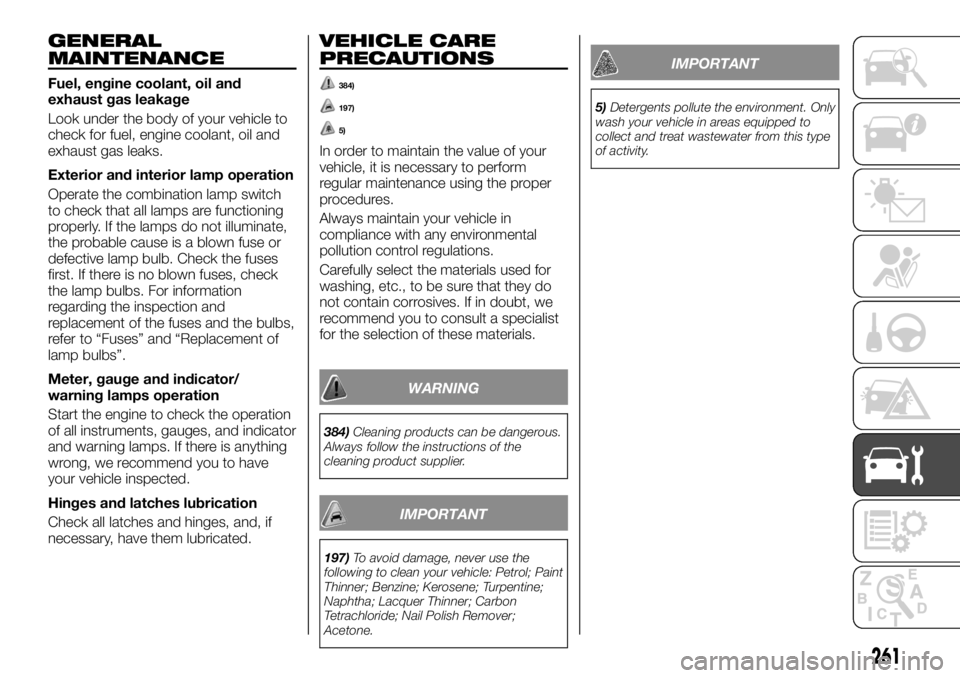
GENERAL
MAINTENANCE
Fuel, engine coolant, oil and
exhaust gas leakage
Look under the body of your vehicle to
check for fuel, engine coolant, oil and
exhaust gas leaks.
Exterior and interior lamp operation
Operate the combination lamp switch
to check that all lamps are functioning
properly. If the lamps do not illuminate,
the probable cause is a blown fuse or
defective lamp bulb. Check the fuses
first. If there is no blown fuses, check
the lamp bulbs. For information
regarding the inspection and
replacement of the fuses and the bulbs,
refer to “Fuses” and “Replacement of
lamp bulbs”.
Meter, gauge and indicator/
warning lamps operation
Start the engine to check the operation
of all instruments, gauges, and indicator
and warning lamps. If there is anything
wrong, we recommend you to have
your vehicle inspected.
Hinges and latches lubrication
Check all latches and hinges, and, if
necessary, have them lubricated.
VEHICLE CARE
PRECAUTIONS
384)
197)
5)
In order to maintain the value of your
vehicle, it is necessary to perform
regular maintenance using the proper
procedures.
Always maintain your vehicle in
compliance with any environmental
pollution control regulations.
Carefully select the materials used for
washing, etc., to be sure that they do
not contain corrosives. If in doubt, we
recommend you to consult a specialist
for the selection of these materials.
WARNING
384)Cleaning products can be dangerous.
Always follow the instructions of the
cleaning product supplier.
IMPORTANT
197)To avoid damage, never use the
following to clean your vehicle: Petrol; Paint
Thinner; Benzine; Kerosene; Turpentine;
Naphtha; Lacquer Thinner; Carbon
Tetrachloride; Nail Polish Remover;
Acetone.
IMPORTANT
5)Detergents pollute the environment. Only
wash your vehicle in areas equipped to
collect and treat wastewater from this type
of activity.
261
Page 266 of 312
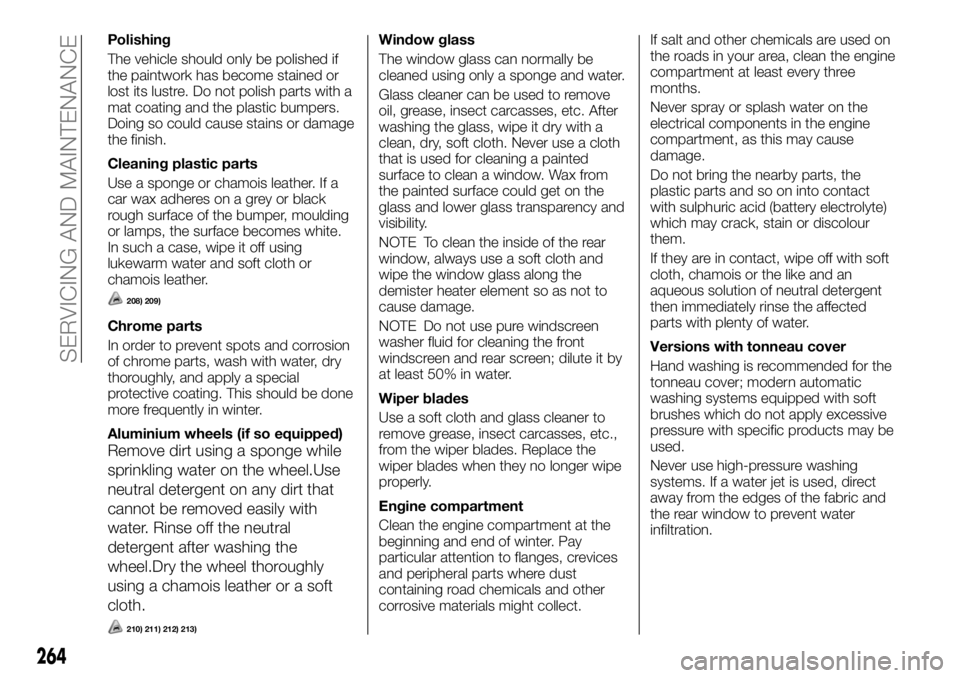
Polishing
The vehicle should only be polished if
the paintwork has become stained or
lost its lustre. Do not polish parts with a
mat coating and the plastic bumpers.
Doing so could cause stains or damage
the finish.
Cleaning plastic parts
Use a sponge or chamois leather. If a
car wax adheres on a grey or black
rough surface of the bumper, moulding
or lamps, the surface becomes white.
In such a case, wipe it off using
lukewarm water and soft cloth or
chamois leather.
208) 209)
Chrome parts
In order to prevent spots and corrosion
of chrome parts, wash with water, dry
thoroughly, and apply a special
protective coating. This should be done
more frequently in winter.
Aluminium wheels (if so equipped)
Remove dirt using a sponge while
sprinkling water on the wheel.Use
neutral detergent on any dirt that
cannot be removed easily with
water. Rinse off the neutral
detergent after washing the
wheel.Dry the wheel thoroughly
using a chamois leather or a soft
cloth.
210) 211) 212) 213)
Window glass
The window glass can normally be
cleaned using only a sponge and water.
Glass cleaner can be used to remove
oil, grease, insect carcasses, etc. After
washing the glass, wipe it dry with a
clean, dry, soft cloth. Never use a cloth
that is used for cleaning a painted
surface to clean a window. Wax from
the painted surface could get on the
glass and lower glass transparency and
visibility.
NOTE To clean the inside of the rear
window, always use a soft cloth and
wipe the window glass along the
demister heater element so as not to
cause damage.
NOTE Do not use pure windscreen
washer fluid for cleaning the front
windscreen and rear screen; dilute it by
at least 50% in water.
Wiper blades
Use a soft cloth and glass cleaner to
remove grease, insect carcasses, etc.,
from the wiper blades. Replace the
wiper blades when they no longer wipe
properly.
Engine compartment
Clean the engine compartment at the
beginning and end of winter. Pay
particular attention to flanges, crevices
and peripheral parts where dust
containing road chemicals and other
corrosive materials might collect.If salt and other chemicals are used on
the roads in your area, clean the engine
compartment at least every three
months.
Never spray or splash water on the
electrical components in the engine
compartment, as this may cause
damage.
Do not bring the nearby parts, the
plastic parts and so on into contact
with sulphuric acid (battery electrolyte)
which may crack, stain or discolour
them.
If they are in contact, wipe off with soft
cloth, chamois or the like and an
aqueous solution of neutral detergent
then immediately rinse the affected
parts with plenty of water.
Versions with tonneau cover
Hand washing is recommended for the
tonneau cover; modern automatic
washing systems equipped with soft
brushes which do not apply excessive
pressure with specific products may be
used.
Never use high-pressure washing
systems. If a water jet is used, direct
away from the edges of the fabric and
the rear window to prevent water
infiltration.
264
SERVICING AND MAINTENANCE
Page 268 of 312
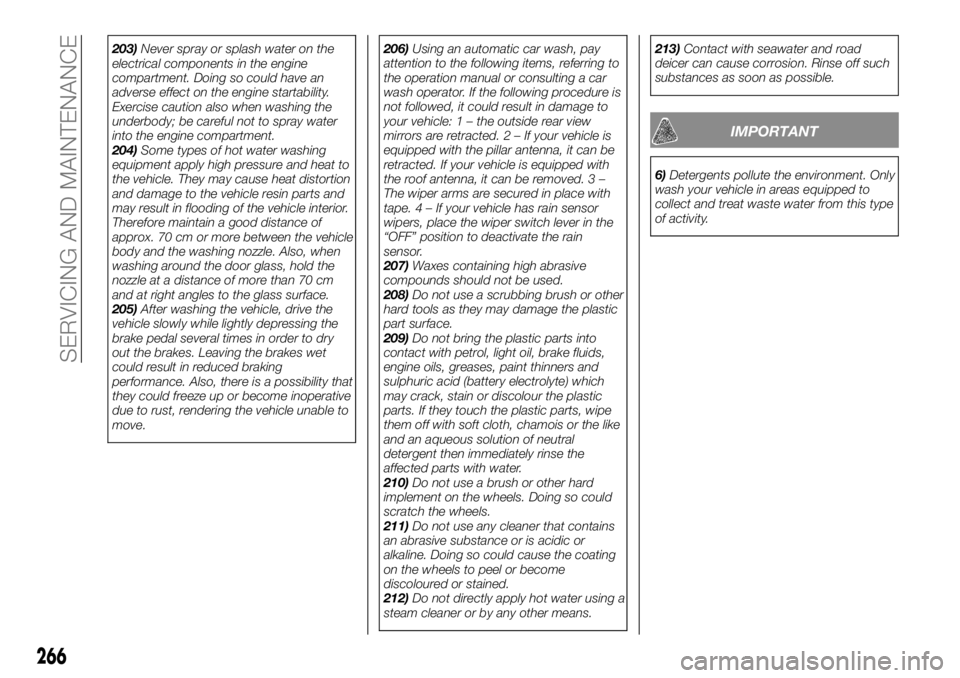
203)Never spray or splash water on the
electrical components in the engine
compartment. Doing so could have an
adverse effect on the engine startability.
Exercise caution also when washing the
underbody; be careful not to spray water
into the engine compartment.
204)Some types of hot water washing
equipment apply high pressure and heat to
the vehicle. They may cause heat distortion
and damage to the vehicle resin parts and
may result in flooding of the vehicle interior.
Therefore maintain a good distance of
approx. 70 cm or more between the vehicle
body and the washing nozzle. Also, when
washing around the door glass, hold the
nozzle at a distance of more than 70 cm
and at right angles to the glass surface.
205)After washing the vehicle, drive the
vehicle slowly while lightly depressing the
brake pedal several times in order to dry
out the brakes. Leaving the brakes wet
could result in reduced braking
performance. Also, there is a possibility that
they could freeze up or become inoperative
due to rust, rendering the vehicle unable to
move.206)Using an automatic car wash, pay
attention to the following items, referring to
the operation manual or consulting a car
wash operator. If the following procedure is
not followed, it could result in damage to
your vehicle: 1 – the outside rear view
mirrors are retracted.2–Ifyour vehicle is
equipped with the pillar antenna, it can be
retracted. If your vehicle is equipped with
the roof antenna, it can be removed. 3 –
The wiper arms are secured in place with
tape.4–Ifyour vehicle has rain sensor
wipers, place the wiper switch lever in the
“OFF” position to deactivate the rain
sensor.
207)Waxes containing high abrasive
compounds should not be used.
208)Do not use a scrubbing brush or other
hard tools as they may damage the plastic
part surface.
209)Do not bring the plastic parts into
contact with petrol, light oil, brake fluids,
engine oils, greases, paint thinners and
sulphuric acid (battery electrolyte) which
may crack, stain or discolour the plastic
parts. If they touch the plastic parts, wipe
them off with soft cloth, chamois or the like
and an aqueous solution of neutral
detergent then immediately rinse the
affected parts with water.
210)Do not use a brush or other hard
implement on the wheels. Doing so could
scratch the wheels.
211)Do not use any cleaner that contains
an abrasive substance or is acidic or
alkaline. Doing so could cause the coating
on the wheels to peel or become
discoloured or stained.
212)Do not directly apply hot water using a
steam cleaner or by any other means.213)Contact with seawater and road
deicer can cause corrosion. Rinse off such
substances as soon as possible.
IMPORTANT
6)Detergents pollute the environment. Only
wash your vehicle in areas equipped to
collect and treat waste water from this type
of activity.
266
SERVICING AND MAINTENANCE
Page 273 of 312
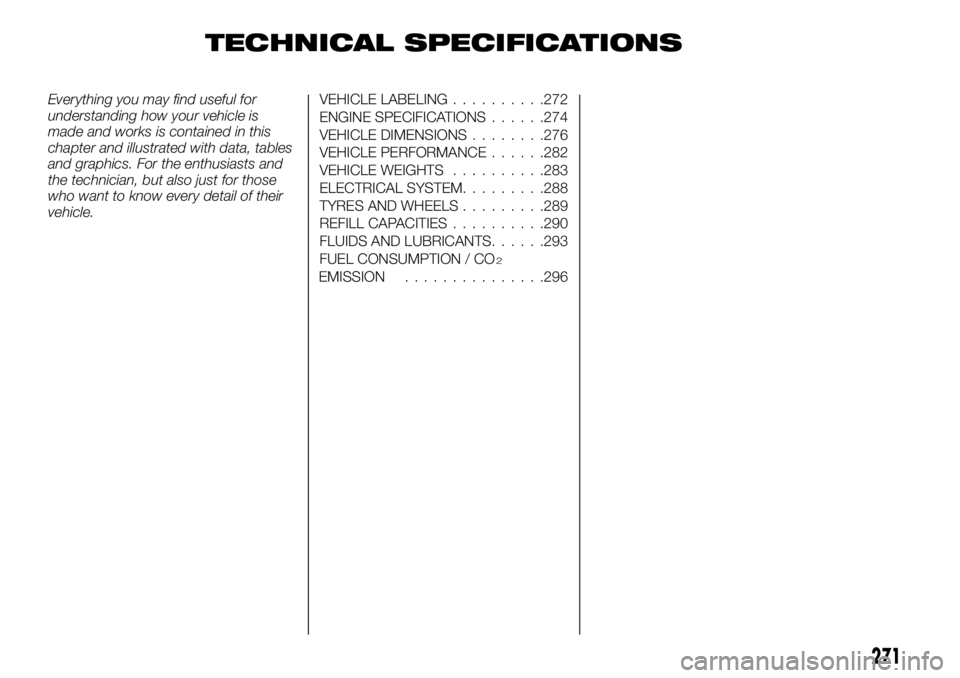
TECHNICAL SPECIFICATIONS
Everything you may find useful for
understanding how your vehicle is
made and works is contained in this
chapter and illustrated with data, tables
and graphics. For the enthusiasts and
the technician, but also just for those
who want to know every detail of their
vehicle.VEHICLE LABELING..........272
ENGINE SPECIFICATIONS......274
VEHICLE DIMENSIONS........276
VEHICLE PERFORMANCE......282
VEHICLE WEIGHTS..........283
ELECTRICAL SYSTEM.........288
TYRES AND WHEELS.........289
REFILL CAPACITIES..........290
FLUIDS AND LUBRICANTS......293
FUEL CONSUMPTION / CO
2
EMISSION...............296
271
Page 274 of 312
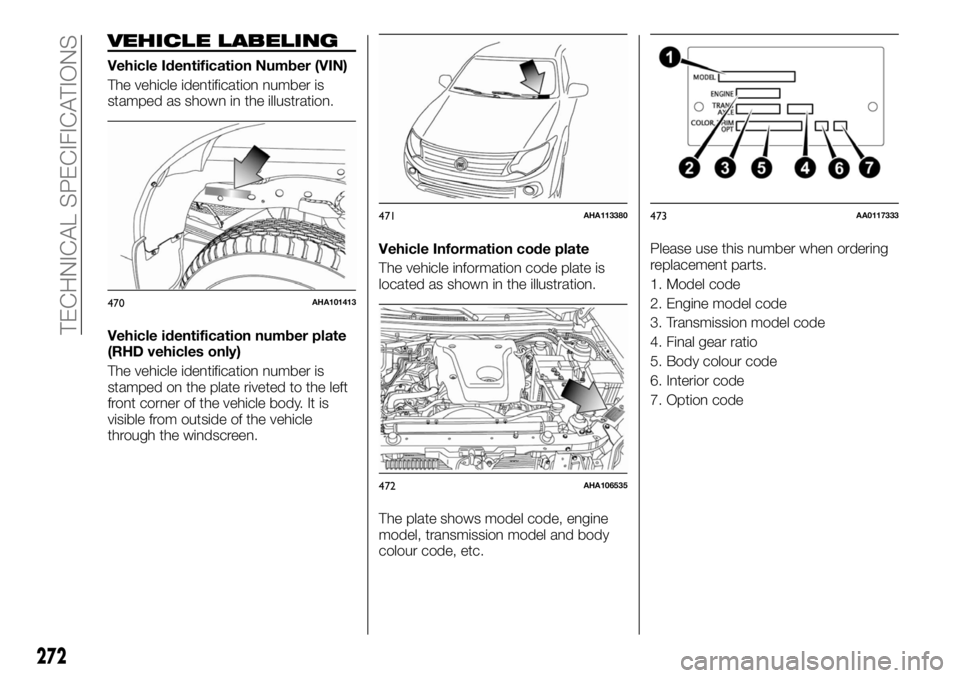
VEHICLE LABELING
Vehicle Identification Number (VIN)
The vehicle identification number is
stamped as shown in the illustration.
Vehicle identification number plate
(RHD vehicles only)
The vehicle identification number is
stamped on the plate riveted to the left
front corner of the vehicle body. It is
visible from outside of the vehicle
through the windscreen.Vehicle Information code plate
The vehicle information code plate is
located as shown in the illustration.
The plate shows model code, engine
model, transmission model and body
colour code, etc.Please use this number when ordering
replacement parts.
1. Model code
2. Engine model code
3. Transmission model code
4. Final gear ratio
5. Body colour code
6. Interior code
7. Option code
470AHA101413
471AHA113380
472AHA106535
473AA0117333
272
TECHNICAL SPECIFICATIONS
Page 275 of 312
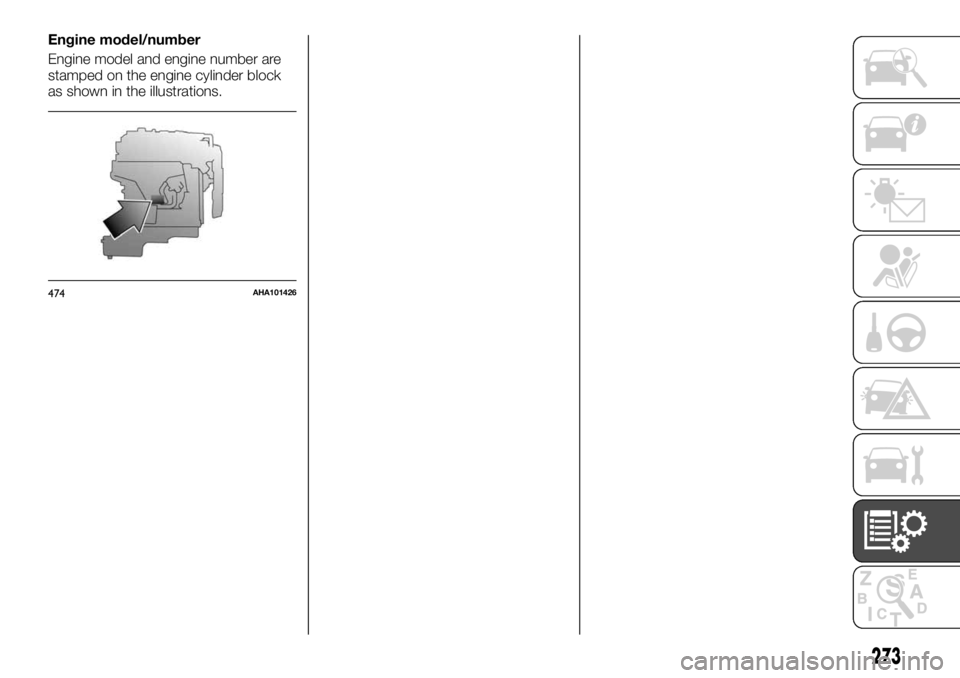
Engine model/number
Engine model and engine number are
stamped on the engine cylinder block
as shown in the illustrations.
474AHA101426
273
Page 276 of 312
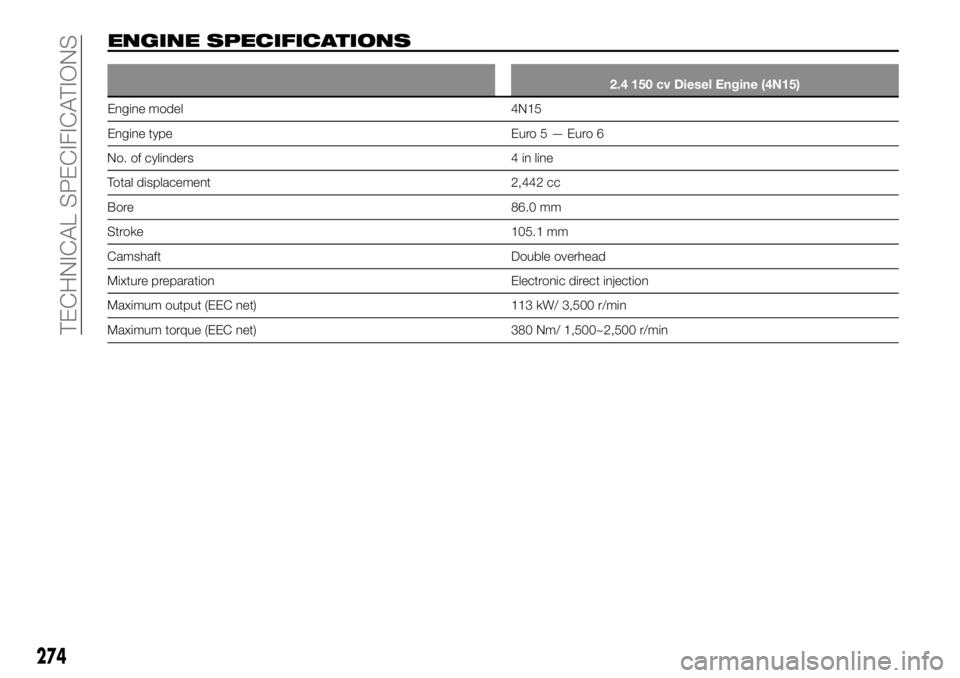
ENGINE SPECIFICATIONS
2.4 150 cv Diesel Engine (4N15)
Engine model 4N15
Engine type Euro5—Euro6
No. of cylinders 4 in line
Total displacement 2,442 cc
Bore 86.0 mm
Stroke 105.1 mm
Camshaft Double overhead
Mixture preparation Electronic direct injection
Maximum output (EEC net) 113 kW/ 3,500 r/min
Maximum torque (EEC net) 380 Nm/ 1,500~2,500 r/min
274
TECHNICAL SPECIFICATIONS
Page 277 of 312
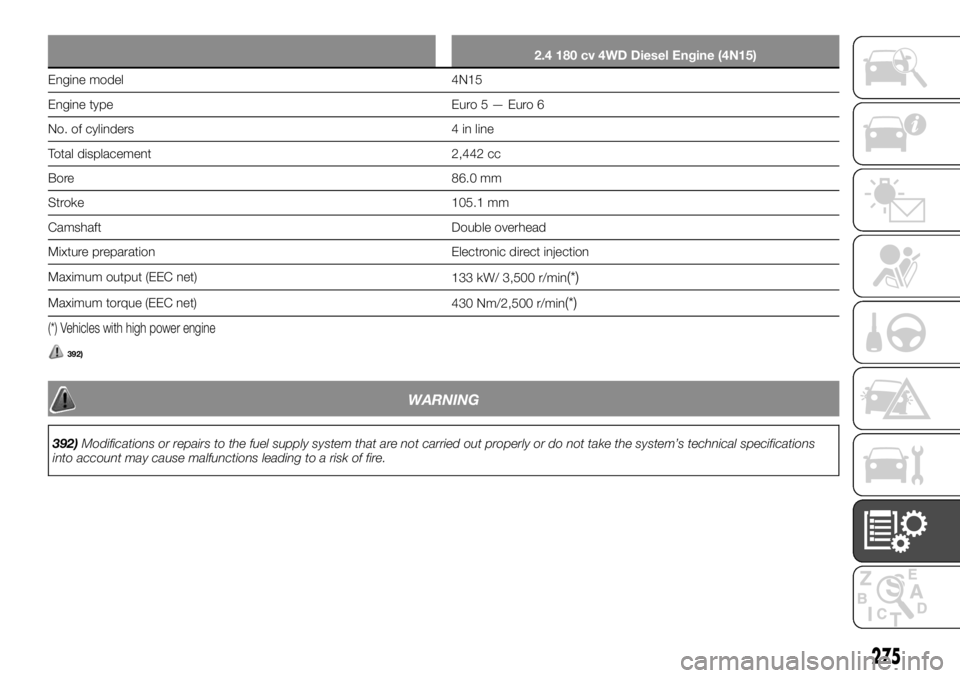
2.4 180 cv 4WD Diesel Engine (4N15)
Engine model 4N15
Engine type Euro5—Euro6
No. of cylinders 4 in line
Total displacement 2,442 cc
Bore 86.0 mm
Stroke 105.1 mm
Camshaft Double overhead
Mixture preparation Electronic direct injection
Maximum output (EEC net)
133 kW/ 3,500 r/min
(*)
Maximum torque (EEC net)
430 Nm/2,500 r/min(*)
(*) Vehicles with high power engine
392)
WARNING
392)Modifications or repairs to the fuel supply system that are not carried out properly or do not take the system’s technical specifications
into account may cause malfunctions leading to a risk of fire.
275